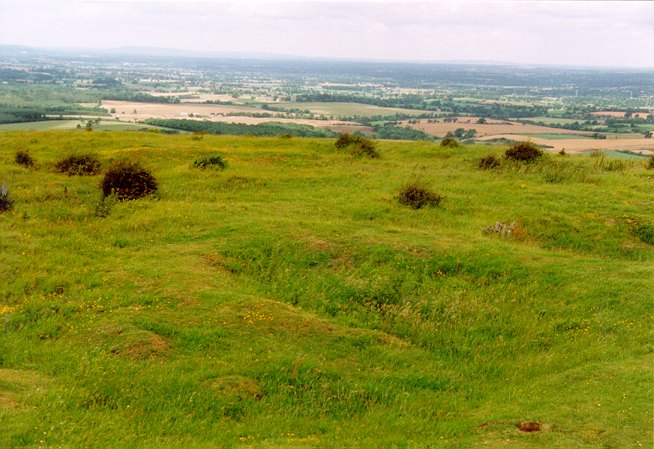 |
Flint digging at the summit of Wolstonbury Hill, appears to have been conducted in the late 18th and early 19th century by inmates from Hurstpierpoint Workhouse. Flint was extracted by the cutting of open pits and much of the interior of the main enclosure has been obliterated in the course of the quarrying. It is probable that archaeological artifacts recovered during the course of such work contributed, at least in part, to a number of large local antiquarian collections. Digging activity appears to have ceased by 1862. |
A rough plan of the earthworks was published in 1806 and, though sketchy, appears to show an original entrance at the south. This area has now been obliterated by quarry pits. A possible "tumulus", no longer visible, is also marked on this survey within the north west quadrant. Colonel Augustus Lane Fox (later to become General Pitt-Rivers) briefly surveyed Wolstonbury C in 1867 and noted the density of worked flints from the western slopes and interior of the main enclosure.
An aerial photograph taken in 1928 revealed the existence of a faint oval earthwork (Wolstonbury A) within the area enclosed by the main rampart circuit (Wolstonbury C). The southern edge of the enclosure appeared to be overlain by, making it stratigraphically earlier than, enclosure C.
Limited excavation work was conducted by Elliot Cecil Curwen in October
1929 upon the main and inner enclosure (C and A). 'Romano-British' pottery,
animal bone and a single hammerstone were recovered from the areas of 'shallow
scoop' exposed within enclosure A, while a single sherd of Early Bronze
Age pottery and "quantities" of flint flakes (number not specified) were
retrieved from the primary silting of the internal ditch of enclosure C.
Curwen concluded that the Early Bronze Age pottery and struck flints were
residual.

A "cross-ridge dyke" or linear ditch system lies to the immediate south
of Wolstonbury C. The north west - south east aligned, linear feature can
be traced on the ground for a distance of some 220m, bisecting the gentle
southerly approach to Wolstonbury C. The remains of at least two further
round mounds, presumably representing barrow structures, lie to the immediate
south and south west of Wolstonbury C and to the north of the cross-ridge
dyke. Both have been badly truncated through ploughing.